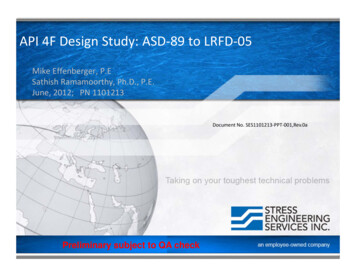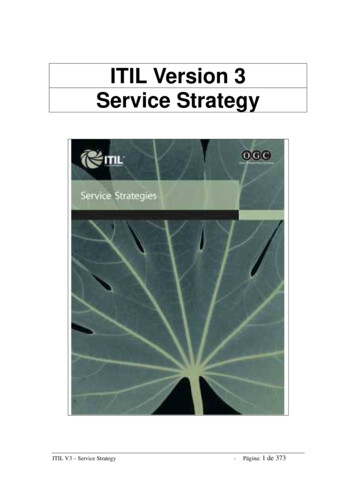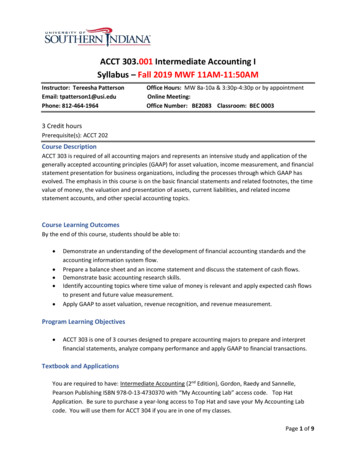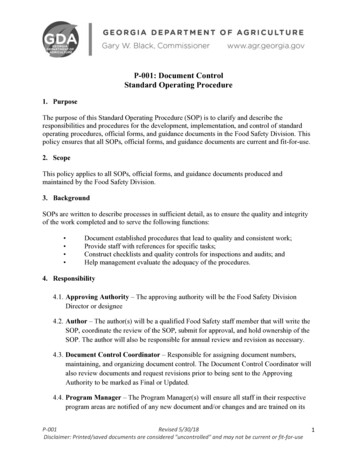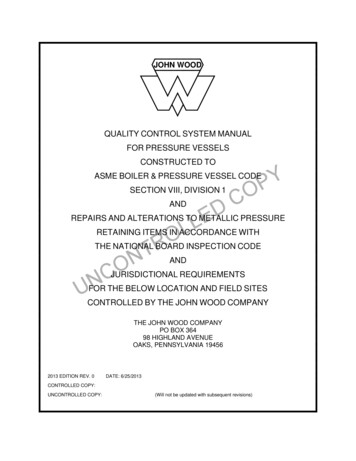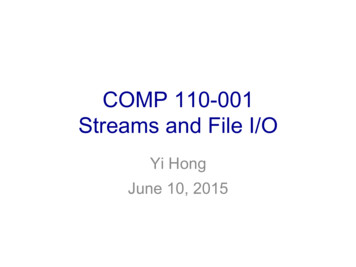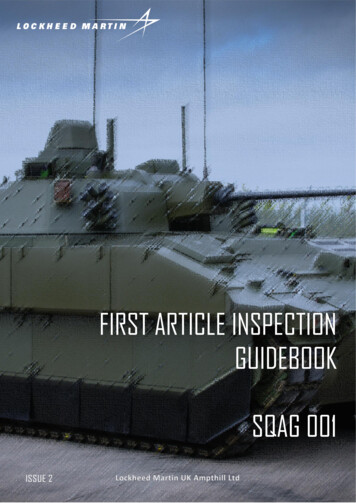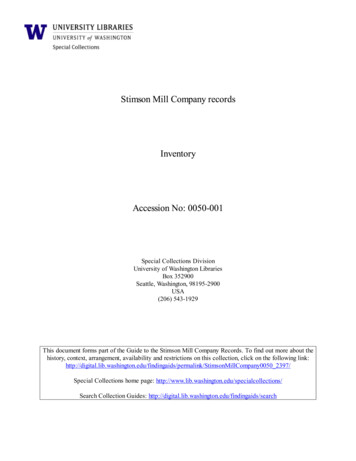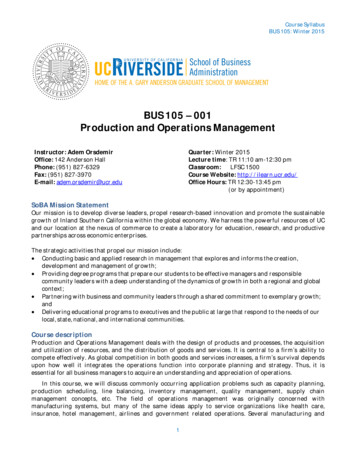
Transcription
This ATG is referenced in an endnote at the Bradford Tax Institute. CLICK HERE to go to the home page.Internal Revenue ServiceRetail IndustryAudit Technique Guide (ATG)NOTE: This guide is current through the publication date. Since changesmay have occurred after the publication date that would affect the accuracyof this document, no guarantees are made concerning the technicalaccuracy after the publication date.This material was designedspecifically for trainingpurposes only. Under nocircumstances should thecontents be used or cited asauthority for setting orsustaining a technicalposition.publish.no.irs.govTrng 10247-001 (Rev. 2-09)Catalog Number 47515G
Retail Industry ATGTable of ContentsChapter 1: Description of the Retailer IndustryPurpose of ATGDescription of a RetailerWhat Retailers DoDemographics of Retail IndustryRetail EntitiesUseful Retail Web SitesGeneral Retail Industry Terminology1-11-11-11-21-21-31-3Chapter 2: General Issues in RetailInitial InterviewInformation Document RequestBooks and RecordsIncomeCash RecordsIndirect MethodsSources of ReceiptsOther Retail Income SourcesCost of goods 112-162-192-192-232-23Chapter 3: Examination Techniques for Specific IndustriesE-CommerceIntroductionInitial Interview questionsInformation Document RequestIncomeCost of goods soldExpensesPotential Tax IssuesWeb Sites for /DVDIntroductionIncomeCost of goods soldExpenses3-63-63-63-6
Glossary3-8Gasoline Service StationsIntroductionInitial Interview questionsIncomePotential sources of additional incomeExpensesWeb 83-30Independent Automobile DealershipsIntroductionInitial Interview questionsBooks and RecordsIncomeCost of goods soldPurchasesExpensesRelated Finance CompanyNon-prime or Sub-prime finance contractOther IssuesWeb 63-563-623-733-743-74Direct SellersIntroductionIncomeExpensesStart up ExpensesIRC 195InventoryCost of goods soldPartnership v. Sole ProprietorshipEmployee v. Independent ContractorProfit v. Not-For-Profit IssueNine Factors and AnalysisExamination PracticesWeb Sites for AssistanceCode, Regulations, Revenue Ruling and Court Cases3- 123-1163-1163-117Auto Body/Repair IndustryIntroductionDescription of Auto Body RepairInitial InterviewTour of Business3- 1223- 1223- 1243- 126
Books and RecordsIncomeParts and MaterialsLaborSubletTowingStorageCost of SalesExpensesGlossary3- 1273- 1303- 1333- 1333- 1333- 1333- 1333- 1373- 1413- 143Chapter 4: Examination Techniques for the Food and BeveragesIndustriesRetail Liquor StoresIntroductionIncomeCost of goods soldStatistics4-14-14-24-2Mobile food VendorsIntroductionIncomeCost of goods soldExpensesGlossary4-34-34-44-44-5Pizza RestaurantsIncomeCost of goods soldExpenses4-64-64-7Restaurants and BarsIntroductionIncomeAdditional Income IssuesBar IncomeCost of goods soldExpensesCost SegregationWeb -234-244-31Grocery StoresInitial Interview questions4-33
IncomeCost of goods sold4-334-33Chapter 5: Code, Regulations and Revenue Rulings, Procedures,Court Cases, and IRMsCited Code SectionsCited RegulationsCited Revenue Rulings & Revenue ProceduresCited Court CasesCited IRM Sections5-15-45-65-75-8
CHAPTER 1Description of the Retail IndustryPURPOSE FOR THE AUDIT TECHNIQUE GUIDEThe purpose of this Audit Technique Guide is to provide guidance on conductingincome tax examinations in the retail industry. It incorporates procedures andtechniques that have been shown to be practical or unique to the retail industrythat will be combined with the examiner’s good judgment, skill and experience tocomplete the examination within the shortest possible time with the least burdenpossible to the taxpayer. Use of these techniques does not imply that the objectof the examination is to find a deficiency, but rather to determine whether thereported income and expenses has been accurately reported.Because the facts and circumstances of each taxpayer are unique, theprocedures applied will be slightly different in every examination, and the strategywill remain dynamic. The examiner will combine the techniques that apply toeach specific case and apply his or her basic knowledge to the practical situationat hand.DESCRIPTION OF THE RETAILERRetailers purchase items from a supplier or wholesaler for re-sale at a profit. Theretailer earns his living by making a profit on the re-sale. To do this the retailermay offer only one type of product, where there is little competition, and use asubstantial markup (such as an auto dealership), or the retailer may offer manydifferent products or models, so customers will be certain to find an item to buy inthis store and not in a competitor’s store (such as a convenience store). Someretailers earn a small profit on many items and rely on the volume of sales (suchas grocery stores), or turnover, to account for their profits. For these reasons,the retailer will constantly assess whether items for sale are turning overproperly, and if necessary, will retire an item or product and introduce new items or products for sale.WHAT RETAILERS DORetailers purchase a product, markup its cost, and advertise it for sale. Themark-up process is the key to the retailer’s business, because, if the product ismarked-up too high, consumers will not buy it; if it is too low, the retailer will havelost profits and the supply may be quickly exhausted.Another key to the retail business is knowing what the customer needs or wantsand when, how much the customer is willing to pay for the product, what the1-1
competition is charging, and where to find the product at the best possible cost tomake a profit.These items and products held in the retailer’s possession are called inventory.Inventory is money out of the retailer’s pocket, so the retailer tries to keepavailable only the amount that is needed. The retailer only makes money wheninventory is sold, and business profitability is measured by inventory turnoverrates.All decisions made in this process, finding the product to sell, marking up its costand placing it for sale, are made with the expectation of earning a greater profit.DEMOGRAPHICS OF THE RETAIL INDUSTRYRetailing is one of the largest industries in the United States and accounts forapproximately 10 percent of our gross national product. Retail business coversmany different areas, including auto dealerships, bars, convenience stores,restaurants, gift shops, clothing stores, merchandise stores, etc.There has been enormous growth and innovation in American retailing in thiscentury. Neighborhood markets and drugstores of the early 1900’s havesuccumbed to population growth and demographic shifts to become departmentstores and grocery stores in the 1950’s. As cities became crowded, familiescontinued to move and the interstate road system improved, suburban shoppingcenters and malls were created. Chains, franchises and catalogs have built theminto national brands today. Retail warehouse concepts continue to increase.Technology has enabled product scanning, sophisticated marketing techniquesand Internet shopping.During the past 2 decades the retail industry has been a leader in the number ofmergers and acquisitions. During the 1980’s the Wall Street Journal stated thatthe retail industry was “percolating with mergers and acquisitions”. In recentyears the retail grocery industry has been involved in numerous acquisitions.Technology has played a significant role in acquiring and maintaining inventory.It has allowed a “partnership” between vendors and retailers in quick responsereplenishment of inventories. Point-of-sale terminals, bar coding, customer creditcards, etc. have led to better, more-accurate record keeping by retailers.RETAIL ENTITIESSmall retailers are sometimes called ‘mom and pop’ stores because they arefamily owned and operated. An example of this might be a generic conveniencestore or a boutique in a strip mall. This type of business may be a soleproprietorship. Even if both spouses work in the store, only one may be theproprietor. Only the proprietor spouse may pay self-employment tax.1-2
It is not unusual for ‘mom and pop’ stores to enter into a partnership, or for familymembers to form a partnership. This might be done to give each member ashare in profits or it might be formed because the business is growing.Large retailers may include many store locations and hundreds of employees.Both small and large retailers might include activities reported as sole proprietorson Form 1040, Schedule C, as partnerships on Form 1065, or as corporations onForm 1120 or Form 1120S.USEFUL RETAIL WEB SITESSome useful web sites we recommend looking at include: p://www.bizstats.com Internal Revenue Code Search: http://www.law.cornell.edu/cfr/ - LegalInformation Institute Revenue Ruling /revrulmaster.htm - TaxLinks.Com Treasury Regulations Search: http://www.gpoaccess.gov/cfr/index.html- U.S. Government Printing OfficeUNIQUE GENERAL INDUSTRY TERMINOLOGYThere is some terminology and practices unique to the industry. It isrecommended that examiners familiarize themselves with the terms unique tothis industry prior to the initial interview in order to facilitate the examination.Each Retail sub-industry will also have it’s own unique terminology. See theparticular industry section.1-3
Industry TermBar CodeChargebacksCooperativeAdvertisingCost Definition or ExplanationA series of vertical or horizontal parallel lines forming acode that is optically read and interpreted by a bar codescanner. Used on enveloped and form for rapid entryof data and for sorting. Bar coding may be anindication that the inventory is computerized.The retailer’s invoice for claims against a vendorresulting from items such as damaged merchandise,cooperative advertising costs, adjustments, and therecovery of transportation charges for improperlyrouted merchandise. Charge backs are usually shownon the vendor’s invoices.Advertising paid for jointly by the advertiser and itswholesalers or retailers. For example, the landlord of astrip mall may collect a percentage of advertising fromeach tenant. This is used for advertising that willbenefit all of the tenants.The average relationship existing between the cost ofmerchandise and the retail value of the items handledduring an accounting period. The dollar value of theinventory at cost is divided by the dollar value of theinventory at retail.A method of deferring payments whereby goods areretained by the store until the customer has completedpayments for them.A reduction of an originally established selling orprevious retail price.The difference between cost price of goods and theirretail price. The initial margin between the selling priceand cost. It also is referred to as mark-on or grossmargin.Additional markup: An increase above the originalselling price.A reduction in the price of an item after it has beensubject to an additional markup. Markup cancellationnever exceeds the amount of additional markup appliedto an item.A reduction in the selling price after there has been anadditional markup. The reduction does not reduce theselling price below the original selling price.MarkdownCancellationsThe increase in the retail price of an item that has beenreduced.1-4
Industry TermDefinition or ExplanationAn increase in the selling price, following a markdown,which does not raise the new selling price above theoriginal selling price.PromotionalMarkdownsA lowering of the retail price hoping to encouragegreater store traffic. Unlike clearance markdowns,promotional markdowns are regarded as an integralpart of some retailer’s offensive strategy calculated toincrease sales. Frequently the promotional markdownsare temporary.Push MoneyBonus money paid by a vendor or a retailer to salespeople for selling specially designated merchandise.A cooperative effort between retailers and theirsuppliers aimed at reducing retail inventory whileproviding a merchandise supply that more closelyaddresses the actual buying patterns of consumers.An accounting technique for recording all inventoryinputs, including sales, purchases, markdowns, and soon, at their retail values. Purchased items are recordedat cost.The gradual loss of inventory over time due to damage,misplacement, or theft.Retail outlets that maintain a large selection in a limitedline of merchandise.A book, maintained by the buyer, in which are enteredadditions to stock (inventory) in the form ofmerchandise received from vendors, and merchandisedeductions which represent sales to customers.A measure of an item of merchandise for inventorymanagement. In inventory control and identificationsystems the (SKU) represents the smallest unit forwhich sales and stock records are maintained.A condition where the actual items on hand, asdetermined by physical inventory is greater than theamount indicated in the stock (inventory) records.A deduction from the agreed price, usually expressedas a percentage or a series of percentages that is usedin commerce to encourage prompt payment of bills;should not be entered in the books of account, norshould it be considered to be a type of earnings.In retailing, a non-selling area devoted to such supportservices as apparel alterations, etc.UPC is a categorization where each item is given a ten-Quick Response(QR) InventorySystemRetail Method ofInventoryShrinkageSpecialty StoresStock BookStock Keeping Unit(SKU)Stock OverageTrade DiscountWorkroomUniversal Product1-5
Industry TermCode (UPC)Retail PriceDef
Initial Interview questions 3-10 Income 3-11 Potential sources of additional income 3-14 Expenses 3-17 Web Sites 3-28 Glossary 3-28 Statistics 3-30 Independent Automobile Dealerships Introduction 3-31 Initial Interview questions 3-36 Books and Records 3-40 Income 3-41

